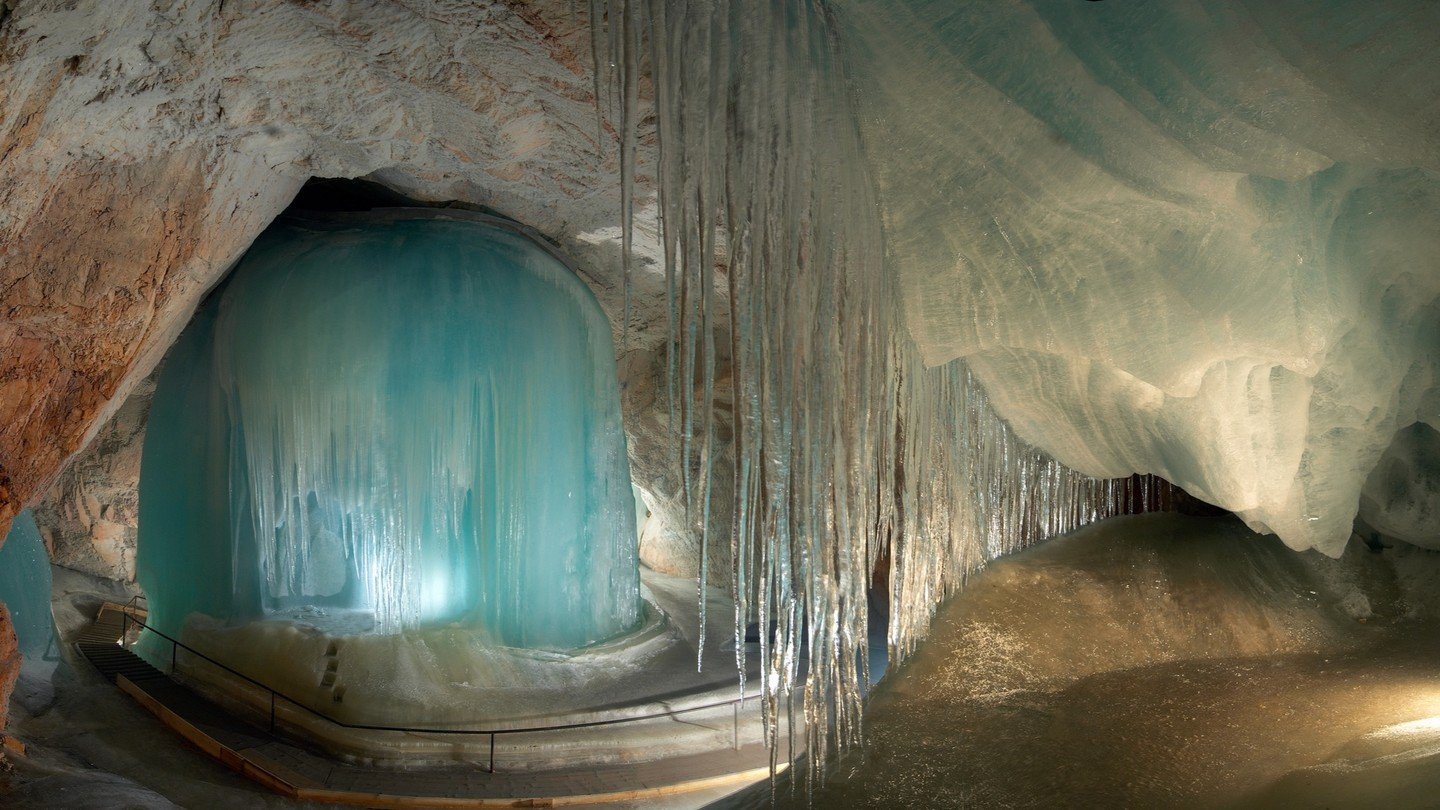Beneath the surface of the Earth lies a hidden world of ice and wonder. Ice caves, also known as glacier caves, are formed by the melting and refreezing of glacial ice over centuries. These natural marvels are not only visually stunning but also provide valuable insights into the Earth’s geological history and the impact of climate change. From the majestic ice formations of Vatnajökull in Iceland to the surreal beauty of the Eisriesenwelt in Austria, join us as we explore the top 12 largest ice caves in the world.
Eisriesenwelt, Austria

Eisriesenwelt, which translates to “World of the Ice Giants,” is the largest ice cave in the world. Located in the Austrian Alps near the town of Werfen, this natural wonder extends over 42 kilometers (26 miles) into the heart of the Hochkogel mountain. The cave’s entrance is an impressive sight, with a massive arch spanning 20 meters (65 feet) high and 18 meters (59 feet) wide.
Inside, visitors are greeted by a labyrinth of ice formations, including towering ice stalagmites, frozen waterfalls, and crystal-clear ice streams. The cave’s most famous feature is the “Ice Palace,” a vast chamber filled with intricate ice sculptures created by nature over thousands of years. Due to the cave’s high altitude and constant sub-zero temperatures, the ice remains frozen year-round, making it a popular destination for adventurers and nature enthusiasts alike.
Vatnajökull Glacier Caves, Iceland

Iceland, known as the “Land of Fire and Ice,” is home to some of the most breathtaking ice caves in the world. The Vatnajökull Glacier, Europe’s largest ice cap, covers approximately 8% of the country’s surface and conceals a network of stunning ice caves beneath its surface.
The most famous of these caves is the Crystal Cave, a mesmerizing tunnel of blue ice that seems to glow from within. The cave’s ethereal beauty is created by the interplay of light and the ice’s natural blue hue, resulting in an otherworldly atmosphere that has captivated visitors from around the globe.
Other notable ice caves within the Vatnajökull Glacier include the Black Diamond Cave, known for its dark, ash-streaked ice, and the Waterfall Cave, which features a frozen cascade of ice that resembles a giant waterfall frozen in time.
Mendenhall Glacier Ice Caves, Alaska, USA
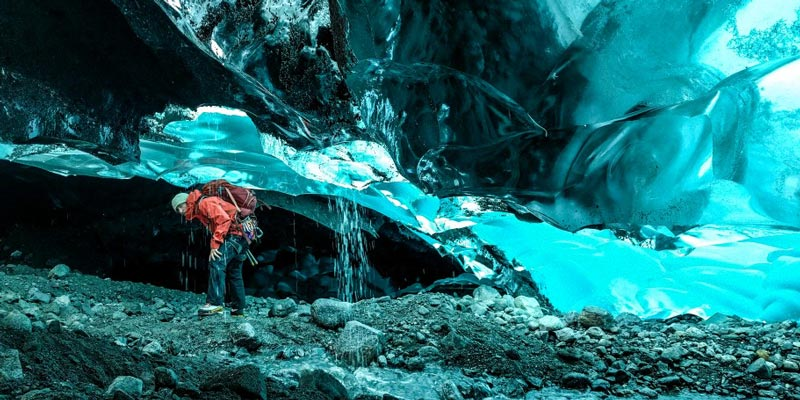
The Mendenhall Glacier, located just outside of Juneau, Alaska, is home to a series of stunning ice caves that have become increasingly popular with tourists in recent years. The glacier, which spans over 12 miles (19 kilometers), has been slowly retreating due to climate change, revealing a network of caves carved out by the melting ice.
The most accessible and well-known of these caves is the Mendenhall Ice Cave, a surreal tunnel of blue ice that stretches over 12 miles (19 kilometers) into the heart of the glacier. Visitors can explore the cave’s winding passages and marvel at the intricate ice formations, including delicate ice crystals and smooth, sculpted walls.
However, accessing the Mendenhall Ice Caves can be treacherous, as the glacier is constantly shifting and changing. Visitors are advised to book guided tours with experienced local operators who can navigate the ever-changing landscape and ensure a safe and enjoyable experience.
Dobšinská Ice Cave, Slovakia

The Dobšinská Ice Cave, located in the Slovak Paradise National Park, is one of the most significant ice caves in Europe. Discovered in 1870, the cave extends over 1,483 meters (4,865 feet) and boasts a total ice volume of approximately 145,000 cubic meters (5,120,000 cubic feet).
What sets the Dobšinská Ice Cave apart from other ice caves is its unique microclimate, which allows the ice to remain stable year-round. The cave’s interior is a wonderland of ice formations, including towering ice columns, delicate ice curtains, and intricate ice crystals that sparkle in the dim light.
Visitors can explore the cave via a series of wooden walkways and stairs, which wind through the cave’s most impressive chambers, including the Great Hall, which features an ice column measuring over 9 meters (30 feet) tall.
Erebus Glacier Caves, Antarctica

The Erebus Glacier Caves, located on Ross Island in Antarctica, are some of the most remote and least explored ice caves in the world. Formed by the geothermal heat of the nearby Mount Erebus volcano, these caves are a unique phenomenon that has fascinated scientists and explorers alike.
The caves are carved out of the ancient ice of the Erebus Glacier, which is estimated to be over 1 million years old. Inside, visitors are greeted by a surreal landscape of steam-filled chambers, bubbling ice pools, and intricate ice formations that seem to defy the laws of nature.
Due to their remote location and the extreme conditions of the Antarctic environment, the Erebus Glacier Caves are only accessible to a handful of researchers and adventurers each year. Those who do make the journey are rewarded with a glimpse into a hidden world that few have ever seen.
Skaftafell Ice Cave, Iceland

The Skaftafell Ice Cave, located within the Vatnajökull National Park in Iceland, is a stunning example of the power and beauty of nature. Formed by the melting and refreezing of the Svínafellsjökull Glacier, the cave is a constantly evolving landscape that changes from year to year.
The cave’s interior is a mesmerizing display of blue ice, with smooth, sculpted walls that seem to glow from within. Visitors can explore the cave’s winding passages and marvel at the intricate ice formations, including delicate ice crystals and towering ice columns.
Access to the Skaftafell Ice Cave is limited to guided tours during the winter months, as the cave’s structure is too unstable and dangerous to explore during the summer melt. Experienced local guides lead visitors on a journey through the cave’s most impressive chambers, sharing insights into the geology and history of this natural wonder.
Mer de Glace, France
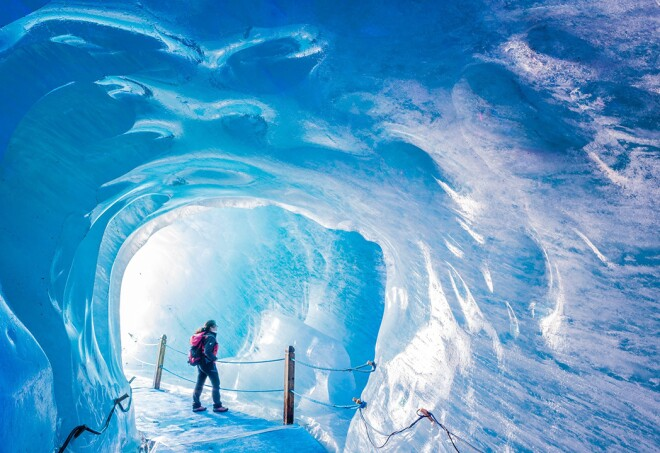
The Mer de Glace, or “Sea of Ice,” is the largest glacier in France and home to a stunning ice cave that has become a popular tourist attraction. Located in the Mont Blanc massif near the town of Chamonix, the Mer de Glace stretches over 7 kilometers (4.3 miles) and is one of the most studied glaciers in the world.
The ice cave, known as the Grotte de Glace, is carved out of the glacier’s terminal face and is accessible via a scenic train ride and a series of walkways and stairs. Inside, visitors are greeted by a cathedral-like chamber of blue ice, with towering walls and intricate ice formations that seem to defy gravity.
The Grotte de Glace is a testament to the power and beauty of nature, but it is also a sobering reminder of the impact of climate change. As the Mer de Glace continues to retreat at an alarming rate, the ice cave’s structure and accessibility are becoming increasingly precarious, making it a must-see destination for those who wish to witness this natural wonder before it disappears.
Kungur Ice Cave, Russia
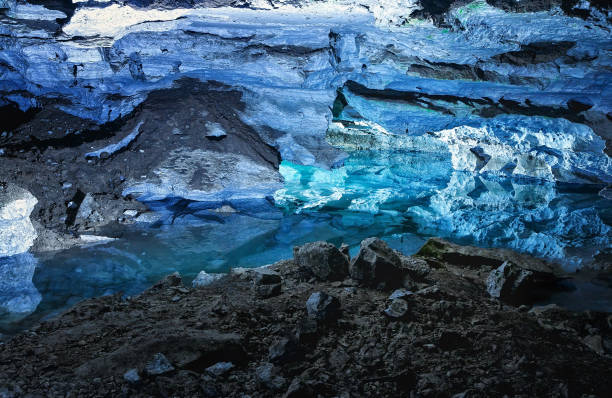
The Kungur Ice Cave, located in the Perm Region of Russia, is one of the most extensive gypsum caves in the world. Stretching over 5.7 kilometers (3.5 miles), the cave is home to a stunning array of ice formations that have been slowly sculpted by nature over thousands of years.
The cave’s interior is a labyrinth of passages and chambers, each with its own unique character and beauty. Visitors can explore the cave’s most impressive features, including the Diamond Grotto, a vast chamber filled with sparkling ice crystals, and the Polar Grotto, where towering ice columns and frozen waterfalls create a surreal winter wonderland.
The Kungur Ice Cave is also notable for its unique microclimate, which allows the ice to remain stable year-round. This has made the cave a popular destination for researchers studying the formation and evolution of ice caves, as well as a sought-after tourist attraction for those seeking a glimpse into this hidden world of ice and wonder.
Eispalast im Hintertuxer Gletscher, Austria

The Eispalast im Hintertuxer Gletscher, or “Ice Palace in the Hintertux Glacier,” is a man-made ice cave located in the heart of the Austrian Alps. Created by a team of skilled ice artists, the cave is a stunning showcase of the beauty and versatility of ice as a medium for artistic expression.
Visitors to the Eispalast are greeted by a magical world of ice and light, with intricate ice sculptures, glittering ice crystals, and colorful light displays that create a truly enchanting atmosphere. The cave’s centerpiece is a massive ice chandelier, which hangs from the ceiling and casts a soft, ethereal glow throughout the space.
In addition to its artistic merits, the Eispalast is also a testament to the ingenuity and skill of its creators, who have managed to construct a stable, safe, and visually stunning ice cave in the heart of one of Europe’s most iconic glaciers.
Kamchatka Ice Cave, Russia
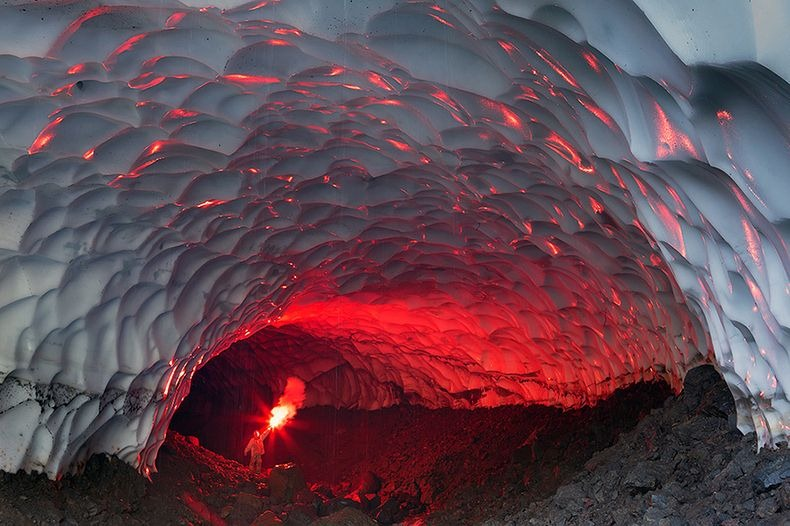
The Kamchatka Ice Cave, located on the Kamchatka Peninsula in Russia’s Far East, is a unique and remote ice cave that has only recently been discovered by scientists and explorers. Formed by the melting and refreezing of the Mutnovsky Glacier, the cave is a testament to the power and beauty of nature in one of the world’s most isolated and inhospitable regions.
The cave’s interior is a stunning display of blue ice, with smooth, sculpted walls and intricate ice formations that seem to defy the laws of nature. Visitors to the cave must navigate a series of narrow passages and chambers, each with its own unique character and beauty.
Due to its remote location and the extreme conditions of the Kamchatka wilderness, the Kamchatka Ice Cave is only accessible to a handful of researchers and adventurers each year. Those who do make the journey are rewarded with a glimpse into a hidden world that few have ever seen, and a chance to witness the raw power and majesty of nature in one of its most pristine and untouched forms.
Eisriesenwelt Tennengebirge, Austria

The Eisriesenwelt Tennengebirge, or “World of the Ice Giants in the Tennen Mountains,” is a massive ice cave system located in the Austrian Alps. Extending over 15 kilometers (9.3 miles) into the heart of the mountain, the cave is one of the largest and most complex ice cave systems in the world.
The cave’s interior is a labyrinth of passages and chambers, each filled with stunning ice formations that have been slowly sculpted by nature over thousands of years. Visitors to the cave can explore its most impressive features, including the “Ice Cathedral,” a vast chamber filled with towering ice columns and delicate ice curtains, and the “Ice Palace,” where intricate ice sculptures and frozen waterfalls create a truly enchanting atmosphere.
The Eisriesenwelt Tennengebirge is also notable for its unique microclimate, which allows the ice to remain stable year-round. This has made the cave a popular destination for researchers studying the formation and evolution of ice caves, as well as a sought-after tourist attraction for those seeking a glimpse into this hidden world of ice and wonder.
Dachstein Giant Ice Cave, Austria
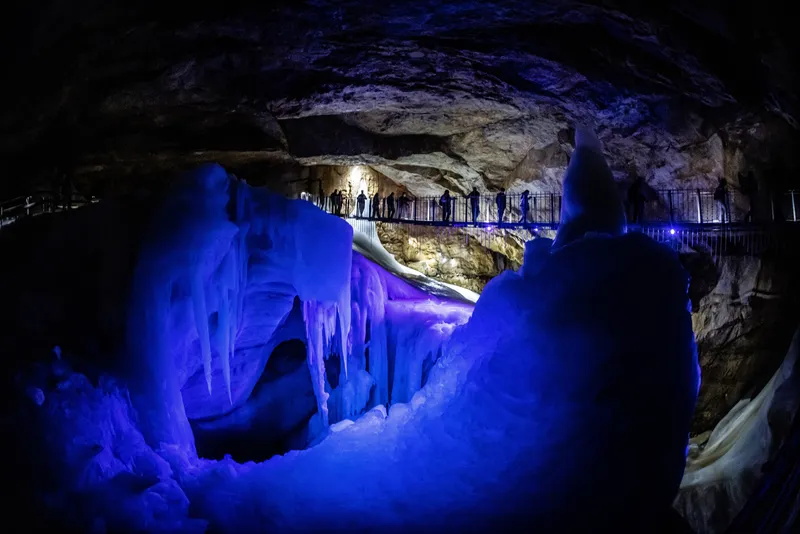
The Dachstein Giant Ice Cave, located in the Dachstein Mountains of Austria, is a massive ice cave system that extends over 15 kilometers (9.3 miles) into the heart of the mountain. Discovered in 1910, the cave is a testament to the power and beauty of nature, with stunning ice formations and a unique microclimate that has fascinated scientists and explorers for over a century.
The cave’s interior is a wonderland of ice and rock, with towering ice columns, delicate ice curtains, and intricate ice crystals that sparkle in the dim light. Visitors to the cave can explore its most impressive chambers, including the “Crystal Dome,” a vast chamber filled with glittering ice formations, and the “Ice Palace,” where massive ice sculptures and frozen waterfalls create a truly enchanting atmosphere.
The Dachstein Giant Ice Cave is also notable for its unique geology, which includes a series of underground lakes and rivers that have carved out the cave’s intricate network of passages and chambers over millions of years. This has made the cave a popular destination for researchers studying the formation and evolution of ice caves, as well as a sought-after tourist attraction for those seeking a glimpse into this hidden world of ice and wonder.
Conclusion
The world’s largest ice caves are a testament to the power and beauty of nature, offering a glimpse into a hidden world of ice and wonder that few have ever seen. From the majestic ice formations of the Eisriesenwelt in Austria to the surreal beauty of the Kamchatka Ice Cave in Russia’s Far East, these natural marvels are a reminder of the incredible diversity and complexity of the Earth’s geological history.
As climate change continues to reshape the world’s glaciers and ice caves, it is more important than ever to appreciate and protect these fragile ecosystems. By exploring and studying these hidden worlds, we can gain a deeper understanding of the Earth’s past, present, and future, and work towards a more sustainable and resilient future for all.

